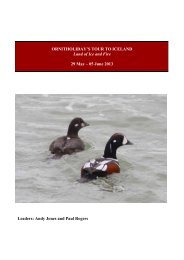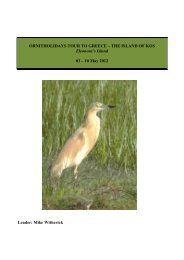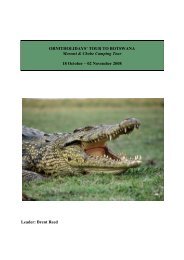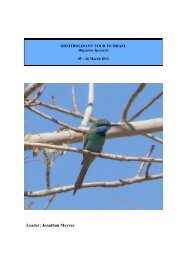Download 2014 Brochure (.pdf) - Ornitholidays
Download 2014 Brochure (.pdf) - Ornitholidays
Download 2014 Brochure (.pdf) - Ornitholidays
Create successful ePaper yourself
Turn your PDF publications into a flip-book with our unique Google optimized e-Paper software.
TA I W A N<br />
Taiwan<br />
Island Endemics<br />
Sunday 13 April – Friday 25 April <strong>2014</strong><br />
Leaders: Simon Boyes and Chiang Kuen-Dar<br />
<strong>2014</strong> Cost £3,799 single room supplement £340<br />
W<br />
hen the Portuguese first saw this subtropical island, situated just 100 miles off mainland China, they called it<br />
Ilha Formosa, or the ‘beautiful island.’ Taiwan is relatively small but it has a spine of mountains, where more than<br />
Kenting<br />
one hundred peaks are over 3,000m high. Its east coast is rugged, while the west side of the island is flat and fertile<br />
with many areas put over to agriculture, including fish farms and rice paddies. Most imagine the country to be heavily industrialized, as indeed it is<br />
around the major cities; though there is also excellent primary forest, rushing rivers, coastal vegetation and an envied extensive national park<br />
structure. Taiwan’s bird list now exceeds 500 species, including 24 endemics (though new splits are on the cards). The central mountains contain<br />
most of these, and we will spend much of our time here, where the scenery is glorious and the air fresh. We will search for star attractions such as<br />
the breathtaking Swinhoe’s and Mikado Pheasants, and the dazzling Taiwan Blue Magpie. We can look for the endangered Black-faced Spoonbill,<br />
which has a world population of about 2,700, at its key wintering site on the west coast. We should see most of the endemic birds, and many other<br />
resident species. By visiting in mid April, we should encounter drier conditions than occur in later months; and migration of many species will be in<br />
progress. We will encounter neither the oppressive heat and humidity of summer, nor the extreme cold (in the mountains) of mid-winter.<br />
Douliou<br />
Tainan<br />
Dasyueshan<br />
Kaoshing<br />
City<br />
Taipei<br />
TAIWAN<br />
Huisun<br />
The experience of birding in Taiwan is now enhanced by the recent publication of the excellent Field Guide to the Birds of East Asia, by Mark Brazil.<br />
Also, if you enjoy good Chinese food then this is a great holiday to choose! Travel with Simon to find out why Taiwan is such a popular Asian<br />
destination. This will be <strong>Ornitholidays</strong> fourth tour to Taiwan.<br />
Mikado Pheasant<br />
ITINERARY<br />
Days 1 to 3<br />
We leave London on a scheduled evening flight<br />
to Taipei, where we arrive the following evening<br />
and transfer to our hotel in the city, for a twonight<br />
stay. The next morning we visit Wulai, a<br />
resort village (with hot springs) in a spectacular<br />
forested valley. Here we seek Taiwan Whistling<br />
Thrush, Plumbeous Redstart, Silver-backed<br />
Needletail and White-bellied Green Pigeon. It is<br />
also a good area for raptors: Crested Goshawk,<br />
Crested Serpent Eagle, Black Eagle and Oriental<br />
Honey-buzzard are all possible. Later we visit<br />
Taipei’s Botanical Gardens, where we hope to<br />
find the endemic Taiwan Barbet and Taiwan<br />
Scimitar-Babbler. Malayan Night Heron,<br />
uncommon and secretive over much of its range,<br />
is comparatively easy to find on the island, and is<br />
often in these gardens. Other birds could include<br />
Grey Treepie, Black-naped Monarch and<br />
Japanese White-eye.<br />
Days 4 to 6<br />
We head south from the capital, and climb into<br />
the mountains. Basing ourselves at Dasyueshan<br />
Forest Recreation Area, we will begin our search<br />
for many of Taiwan's more spectacular<br />
endemics. This area, ranging from 1,000 to 3,000<br />
metres in elevation, features both temperate<br />
mixed forest and boreal conifer forest of fir,<br />
hemlock and cypress. Top among these<br />
endemics are Mikado and Swinhoe's Pheasants,<br />
but we will also be alert for Flamecrest, Rufouscrowned<br />
and Rusty Laughingthrushes, Taiwan<br />
Barwing and Taiwan Sibia. Steere's Liocichla and<br />
Taiwan Yuhina will become familiar birds here.<br />
We will also climb (in our vehicle) for higher<br />
altitude species, such as White-whiskered<br />
Laughingthrush, Johnstone's Robin, Yellowbellied<br />
Bush-Warbler, Ashy Woodpigeon and<br />
Vinaceous Rosefinch. We also have good<br />
chances for White-bellied Green Pigeon,<br />
Bronzed Drongo, Scaly Thrush, Rufous-faced<br />
Warbler, Snowy-browed Flycatcher and Vivid<br />
Niltava. Taiwan Whistling Thrush and Little<br />
Forktails occur along the mountain streams. We<br />
will keep an eye on the treetops for the distinctive<br />
island subspecies of Spotted Nutcracker,<br />
(owstoni), which are the least spotted of all forms<br />
and a candidate for a future split. With patience,<br />
78<br />
For a previous tour report or further information please call: 01794 519445








